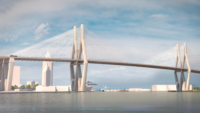Superior Construction is expected to start work next year on a pedestrian swing bridge over the Ashley River in Charleston, S.C. If completed as planned in 2027, the 4,100-ft-long bridge—with a 225-ft-long cable-stayed center swing span for the passage of marine traffic—would rank as the first of its type in the U.S., according to Superior, the design-builder.
Working with design partner Johnson, Mirmiran & Thompson, Superior expects to kick off design for the $72.6-million project in November. The anticipated groundbreaking, with at-grade tie-ins to existing infrastructure on each end of the project, is the second quarter of next year, says Richard Kirkman, Carolinas' division manager at Superior. Work on the bridge itself would start later next year.
The bridge would connect downtown Charleston to the city's West Ashley area. The plan is to build the movable span in the open position to minimize impacts to marine traffic.
“We were challenged by the city to come up with a unique design,” says Kirkman, that included the horizontal cable-stayed movable span. “When you approach a design-build project, you try to approach it with an open mind, and think outside the box.”
The design was developed with engineer TranSystems, and its subcontractor COWI, he adds. That helped the team secure the contract from the city.
According to a city website, the idea for the pedestrian bridge dates to an $18.1-million BUILD grant Charleston received in 2019. The city, county and the Medical University of South Carolina matched the grant to the tune of $4.6 million, for a total $22.7 million.
The city’s initial cost projections of about $42 million were found to be insufficient as firms began to submit proposals, local media reported in September. City officials cited inflation and construction costs for the increase.
The design-build project will be funded by Charleston, Charleston County, the South Carolina Dept. of Transportation and the Federal Highway Administration. The bridge will be constructed with large-diameter drilled shaft foundations of 8 ft to 9 ft.
Five connected longitudinal spans will traverse the river itself. This includes the cable-stayed center span, with its hydraulics for swinging, and four others constructed of traditional girders with cast deck spans. On other parts of the bridge, 34-ft-long spans will cross the marshy areas with a precast prestressed concrete box-slab design stacked transversely to create the riding and walking surface, Kirkman says—an approach that’s expected to speed design, fabrication and construction.
The impetus for the bridge is safety. More than 63,000 cars cross the Ashley River every day on two parallel bridges with narrow sidewalks, which resulted in more than 100 pedestrian-related crashes from 2014-19, according to a release from Superior. A key feature of the bridge will be a V-shaped pylon, while the bridge’s outward-leaning stay cable plane will reduce risk of ice on cables falling onto the pedestrian path.
Most of the bridge will be 15 ft wide, with tapering portions to expand to 24 ft for the five spans crossing the river. The scope of work also includes new movable bridge operations with CCTV monitors, a touchscreen display and discrete pushbuttons for the gates, as well as s trailhead with benches, water stations and bike repair stations.






Post a comment to this article
Report Abusive Comment